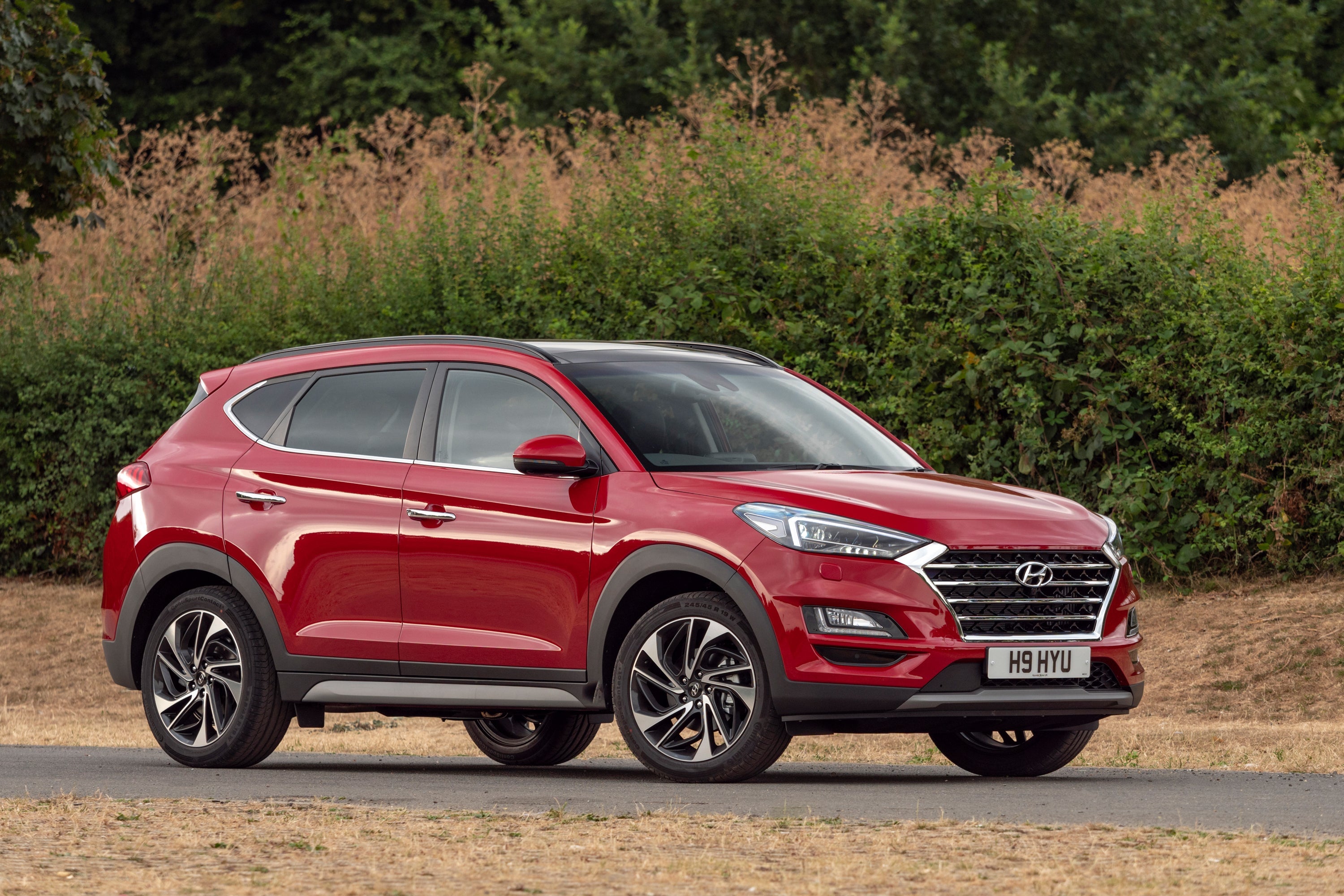Used Hyundai Tucson (2015-2021) Review
Written by Andrew Brady
Quick overview
Pros
- Great levels of kit
- Loads of space inside
- Five-year warranty
Cons
- Not the quickest SUV
- Thirsty petrol engines
- Firm ride on larger alloys
Overall verdict on the Hyundai Tucson
"Buyers have a huge amount of choice when it comes to mid-size SUVs and several rivals in this class are more comfortable or sharper to drive than the Hyundai Tucson. The Tucson still has a lot in its favour though and the pick of the bunch is the 1.6-litre T-GDi in SE Nav trim. It offers the best value and has a bigger boot than the diesel."
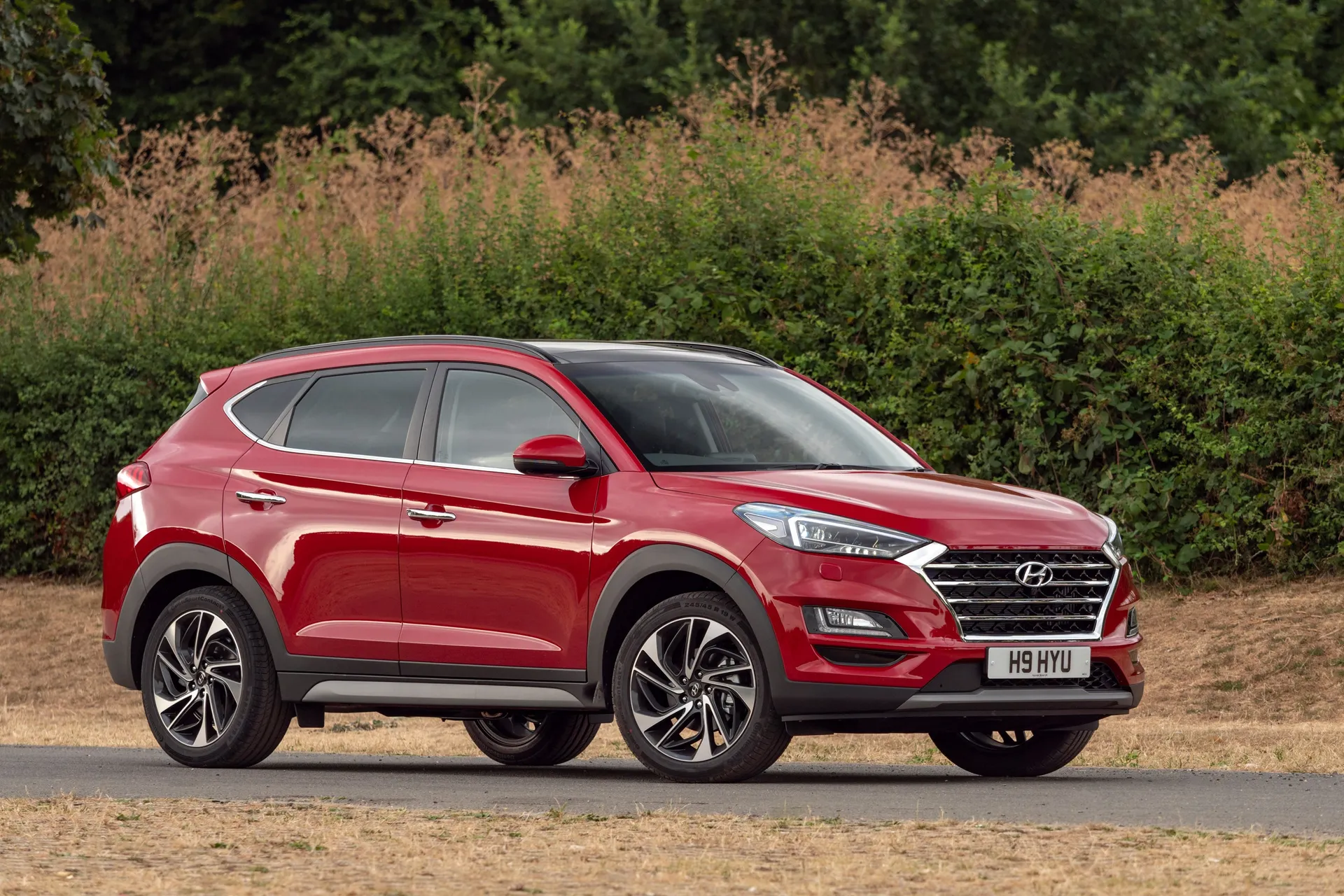
Launched in 2015 but given a thorough makeover in 2018, the Hyundai Tucson has never looked sharper inside or out. This is one of Hyundai's most popular cars. Still, with so many talented rivals, it has its work cut out to remain relevant.
Fortunately, it gets a lot of things right. The interior is smartly laid out, build quality is much improved and it comes with a generous level of standard equipment. In a class where practicality is vitally important, it also nails interior space, with excellent passenger comfort, lots of neat storage cubbies, and an impressive boot.
Every model comes with climate control, a reversing camera, lane-keep assistant and Apple and Android smartphone integration, while our favourite SE Nav trim adds parking sensors, cruise control, and navigation.
Its engine range has kept pace with the latest advances in technology, with a mild-hybrid system fitted to all three diesel models. Basically, it acts like a souped up stop-start system, with a higher voltage battery that can gather energy as you drive, or boost the power when you need more oomph via an electric motor. It also helps improve fuel economy, but you won't notice it working, except at the pumps.
This system is fitted to a 1.6-litre diesel with 115PS or 136PS, and a 2.0-litre diesel engine with 185PS. The latter is now the only Tucson with four-wheel drive and has the most grunt, so it's the one to go for if you need a tow car. As for petrols, there's a 1.6-litre turbo with impressive pace and a breathless non-turbo that's best avoided.
Most of the engines come with a choice between a slick six-speed manual or seven-speed dual-clutch auto. The former is pleasant to use, but while the latter improves performance, it can be a bit jerky and hesitant.
On the road, the Tucson handles neatly, staying upright through corners, but it has less dynamic sparkle than cars like the SEAT Ateca and Mazda CX-5. The steering is numb and lifeless, while the ride has a firm edge to it that worsens on sportier versions with large wheels. It will shimmy and bobble over patchier stretches of road.
For some buyers that won't matter too much and on the motorway, it settles down. In fact, this is a superbly quiet car to travel long distances in, with comfortable seats, relatively hushed engines and little tyre rumble.
Combine this easy-going nature with its spacious interior, decent materials and - on the higher trims at least - a wide range of safety assistance with luxury equipment, and it's good value, with a five-year warranty. Sure, there are SUVs that eclipse the Tucson in some areas, but it's there or thereabouts across the board.
Looking for a used car for sale? We've got 100s of Hyundai Approved Used Cars for Sale for you to choose from, including a wide range of Hyundai Tucson cars for sale. If you're looking for the newer version, you need our Hyundai Tucson review.
Is the Hyundai Tucson right for you?
The Tucson is the kind of car that suits buyers looking for the raised driving position and roomy interior that is common to all SUVs. It makes the Hyundai a great family car and comes well equipped, with few options.
Buying any new car can come with a feeling of uncertainty, but with its five-year, unlimited mileage warranty and an excellent reliability record, the Tucson is perhaps one of the most stress-free purchases you'll make.
Although some of the pricier versions come with four-wheel drive, this is car for on-road adventures only, so we would only stump up for this model if you're planning on towing, or regularly face challenging winter snow.
It certainly looks stylish, but we'd stop short of calling it distinctive - even in racier N Line trim - so if you want a car that turns heads, this probably isn't for you. Similarly, the petrol engines are quite thirsty, which means either going for one of the diesels if you cover high annual mileages, or if that's problematic, a different SUV.
What’s the best Hyundai Tucson model/engine to choose?
In certain trims the Tucson looks fantastic value, but choose the wrong engine or posher grades, and the price shoots up, to the point where it becomes hard to justify. We think the sweet spot is the SE Nav model.
As long as you don't need four-wheel drive (and most don't) this car gives you a good selection of engines to choose from, the nicer infotainment screen, plus SUV essentials like cruise control and rear parking sensors.
In terms of the engine with that trim, whatever you do, don't get the basic non-turbo petrol. It's horribly thirsty, slow and sounds strained when you work it, which you'll have to constantly to get it to move with conviction.
The 1.6-litre turbo is a lot quicker, and the smoothest choice for buyers who don't cover too many miles. Since it doesn't feature any mild-hybrid tech, it undercuts our favourite 136PS diesel by over £2500 on price.
However, if you're covering more than 10,000 miles a year, you'll probably be better off with a diesel. As the difference between getting closer to 40mpg on the motorway than 30mpg will start to add up quite quickly.
What other cars are similar to the Hyundai Tucson?
The Tucson trades on its equipment, interior space, and a five-year manufacturer warranty. If those are all important factors for you, then the Toyota RAV4 has all these good qualities and offers full hybrid drive too.
In fact, this segment is packed with excellent all-rounders that offer varying degrees of head-turning style, some off-road capability, flexible practicality and driving enjoyment. Some of the strongest of these models with similar pricing to the Hyundai are the Skoda Karoq, Peugeot 3008 and SEAT Ateca, but all have merit.
If you would prefer a premium gloss on the five-seat SUV package, the Volvo XC40 has style and space in abundance, with a stunning interior, while the Range Rover Evoque has huge desirability and off-road chops. Just be prepared to pay a lot more.
For keener drivers who want an SUV with sportier handling, the Mazda CX-5 impresses on twisty roads, or if you merely need an affordable diesel with four-wheel drive towing ability, check out the SsangYong Korando.
Comfort and design: Hyundai Tucson interior
"This is another area that Tucson has greatly improved since its facelift. The cabin has a smarter design, with the infotainment touchscreen now sitting proud on top of the dash, with no untidy extra controls underneath."
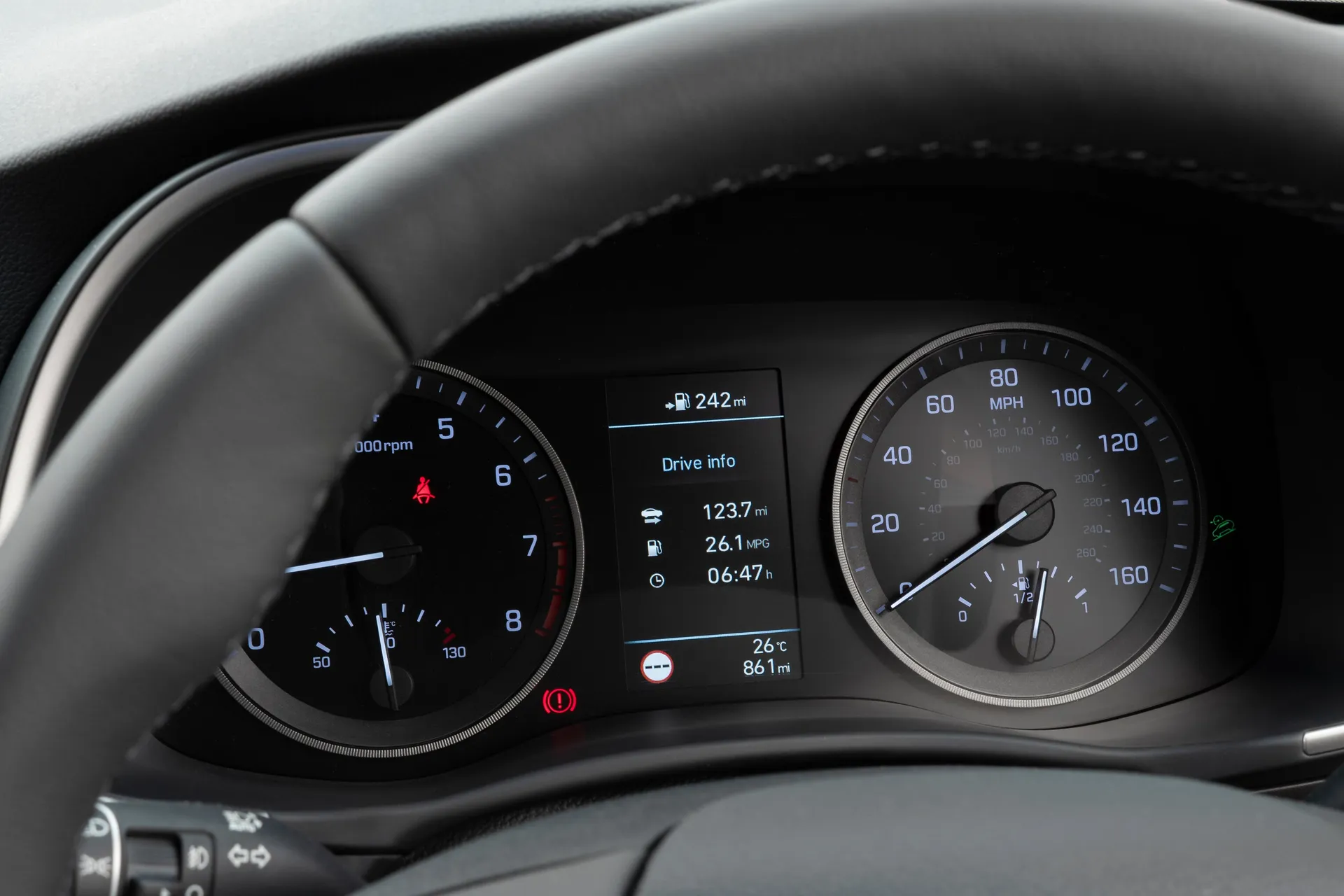
It has freed up space to lower the whole dash (apart from the display), so it feels airier inside, with light flooding the cabin and clear separation between the instruments, screen and heating and ventilation controls below.
What was already a very functional, useable interior now looks that bit slicker, but this design glow-up hasn't taken anything away from the spot-on ergonomics. You won't need to search long to find the right button, and everything is grouped by function, sensibly placed and clearly labelled to avoid any confusion while driving.
The raised driving position provides a great view of the road ahead. The front seats are superb, providing just enough support to stay comfortable for hours on end, but still soft enough to sink down into. If you pick an SE Nav model or above, you'll get lumbar support too, to stave off backache after a day at the controls.
All models offer enough adjustment to the seat and steering column to ensure any driver will find a driving posture that suits them, while Premium models have full electric adjustment plus heated and cooled seats.
Quality and finish
Long gone are the days when buying from a Korean brand meant getting a cheap feeling interior. One look inside the Tucson is enough to convince anyone that Hyundai is now on a level playing field with Europeans.
Everything inside feels sturdy enough to pass muster. And while some of the controls are nicer than others, it is the stuff you'll touch more often, like the steering wheel and climate controls, that feel the best.
Since the refresh in 2018 it looks and feels more upmarket. There's a generous helping of soft-touch plastics on the dashboard and doors, fewer buttons cluttering the centre console and nicer fabrics on cheaper trims.
Step up to the N Line and the sea of sturdy, grey plastic gives way to a sporty red and black motif, with faux leather on the dash (complete with racy red contrast stitching), gloss black trim and leather and suede seats. It all stays the right side of tasteful and the bright metal pedals and and red accents really help lift the cabin.
Top spec Tucsons get full leather upholstery, but there are still areas of flimsy, harder plastics there to gently remind you that you're in an expensive version of a mainstream SUV and not a fully-fledged premium model.
It's these few remaining rough edges (flimsy glovebox lid, scratchy door tops) that will need smoothing over before Hyundai can challenge the best in class. It's plusher than a Nissan Qashqai for sure, but no Audi Q3.
Infotainment: touchscreen, USB, nav and stereo in the Hyundai Tucson
Every Tucson benefits from a touchscreen display, DAB radio, Bluetooth, a set of at least six speakers plus smartphone mirroring via Apple CarPlay and Android Auto, allowing you to plug straight in to use your apps.
Not a bad haul, but a similar level of infotainment to what you'd find in most of its contemporaries. On older cars, you had to buy at least an SE Nav to even get a screen and only used your phone for hands-free calls.
Now, the reason to go for this specification is the fact that it comes with a bigger 8.0-inch touchscreen with clearer graphics, built-in navigation, colourful maps, live traffic alerts and fairly quick responses too.
It's not as sharp as the best systems in this class, but pretty intuitive to use, plus we like the fact that Hyundai gives you physical shortcut buttons on both sides of the display to help you whizz through its various menus.
Sound quality is okay, but you'll want to upgrade to one of the Premium models if you're really into your music. They get an eight-speaker setup and subwoofer, but it's not from a brand anyone is likely to recognise. On the plus side, you'll also get a wireless phone charging pad and more colourful LCD driver's display too.
Space and practicality: Hyundai Tucson boot space
The Tucson should prove to be a versatile family car. It's got a spacious interior, decent sized boot and a number of thoughtful touches that clearly show that this car has been designed with busy parents in mind.
Four adults will fit comfortably and even with five on-board things won't be too cramped. The cabin is wide enough to accommodate three across the rear bench without too much jostling about. Whoever gets the middle spot sits a bit higher than the others and also has to rest their feet on top of the transmission tunnel.
Neat touches like the deeply reclining back rests, extra coat hooks and a rear armrest with a set of integrated cupholders help ensure that it's just as pleasant to travel in the back of the Tucson as it is up front. Its doors open nice and wide, so it's no bother to manoeuvre a bulky child seat into place. The Isofix points for mounting one are covered by flip-down plastic tabs, but they're secured so that you won't instantly lose them.
Only the top-spec cars get a boot that opens at the press of a button, a feature you’ll find on the cheaper versions of many of its rivals, which comes in handy everytime you're carrying fistfuls of shopping to the car.
However, once you're in the boot, there is a lot of space to play with - over 500 litres on petrol models - but if you choose a diesel this reduces slightly, since the mild-hybrid gubbins takes up space underneath the floor.
The load bay is wide and deep, and although the wheel arches intrude a little on either side, it easily takes a set of suitcases, baby stroller, or large packing boxes. If you set the boot floor in its lowest position, you'll be able to fit all of the above underneath the removable load cover, which stows neatly away when not in use.
Pop it back to its higher setting and you have a perfectly flat loading area, with no lip to negotiate. Although you can't fold the seats using handy levers in the boot, once stowed they sit flush with the boot. In this mode you'll have over 1500 litres of luggage volume, and they split 60/40 if you need to carry passengers as well.
Capacity wise, you'll be able to squeeze more into the Hyundai than most. Although a Volkswagen Tiguan and Mazda CX-5 are even roomier with the seats folded, we doubt anyone will have complaints regarding its practicality.
Handling and ride quality: What is the Hyundai Tucson like to drive?
"It may look like a lumbering off-roader on the outside, but the Tucson certainly doesn't feel like that to drive. For starters, the steering is very light. That's great for car parks and mini roundabouts, but not ideal on a B-road."
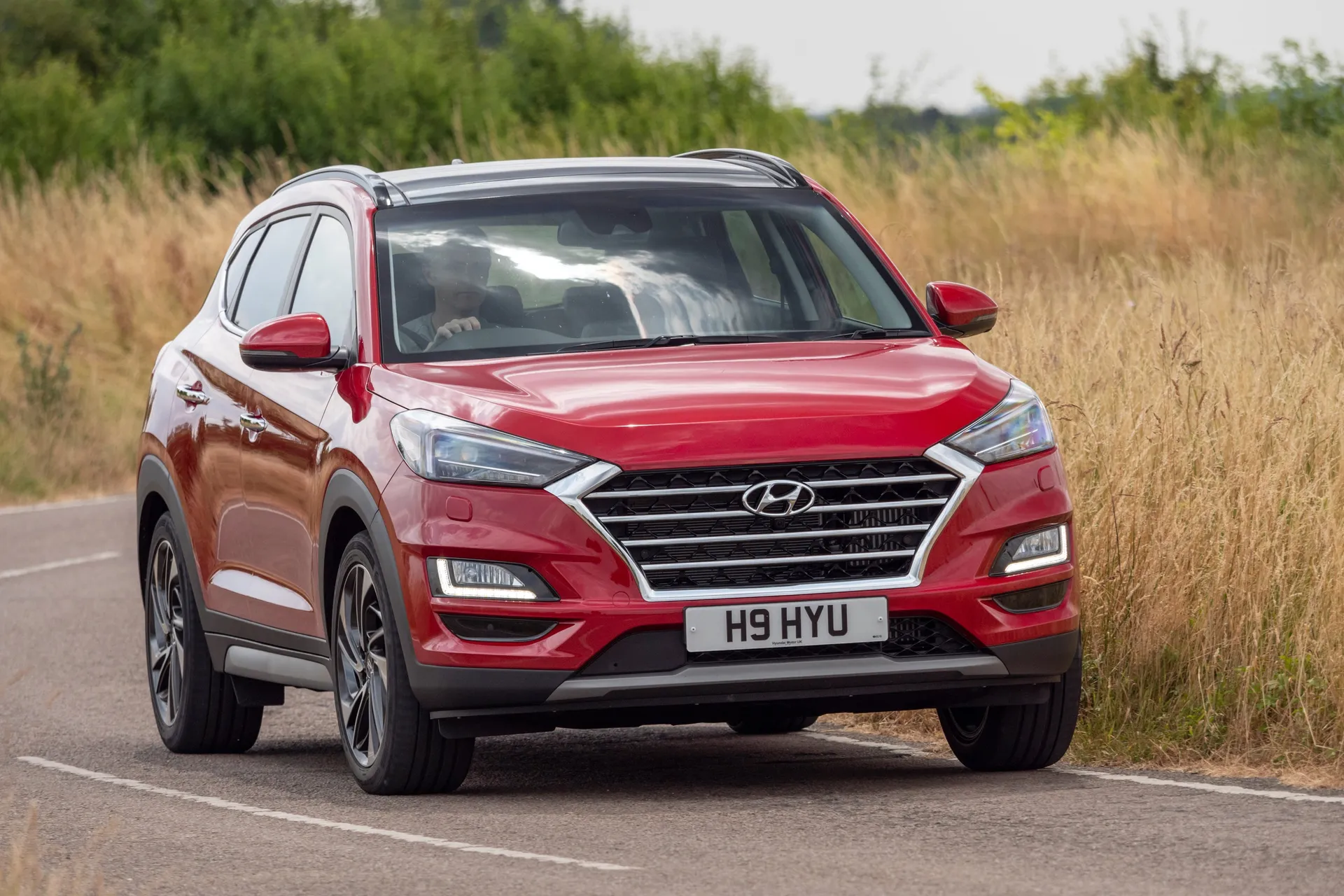
Naturally, ease-of-use will trump sporty handling for most buyers. Even so, the vague and lifeless sensation from the steering leaves its driver in the dark about what the wheels are doing, robbing them of confidence. The loose sense of connection means there's little point hustling it along. It's not as fun as say, a SEAT Ateca.
It's a shame, because in other respects this car handles well. The body doesn't lean over as dramatically as some SUVs in corners, and it won't float or lurch over undulating surfaces, keeping things nicely controlled.
There's a decent amount of grip from the front tyres and you'll struggle to notice the differences between the front- and four-wheel drive versions in dryer conditions. But the latter features a locking diff for muddier work.
Choosing the N Line version (with the 1.6 T-GDi petrol) brings a few mechanical tweaks that supposedly help sharpen the Tucson's handling. It has re-tuned steering and stiffened front and rear suspension. It's a fraction more communicative on a challenging road, but still nowhere near as responsive or agile as a Mazda CX-5.
Picking the sportier model also means riding on a set of 19-inch alloy wheels that do little for ride comfort. As it is, the standard car already feels firm, shimmying over rough sections of road and thumping into potholes. The swollen alloys exacerbate this unwelcome behaviour, making the Tucson feel quite jittery around town.
These are minor niggles though. As long as you stick to a sensible wheel size, the Hyundai won't cause too many disturbances for its passengers, and handles in a competent, stable, but also entirely forgettable way.
What engines and gearboxes are available in the Hyundai Tucson?
When it launched in 2015 the Tucson came with a wide range of two petrol and five diesel engines. At the lower end was a 132PS 1.6-litre non-turbo petrol and a 1.7-litre diesel with 116PS, both with a manual gearbox.
In the mid-range, you could add a turbocharger to the petrol, boosting its output to 177PS, or pick a 1.7-litre with 141PS, which came with the option of a dual-clutch automatic. Top spec cars came equipped with four-wheel drive, and a 2.0-litre diesel engine with either 136PS or 185PS, and a choice of manual or automatic.
It still has the same number today, but there were important changes made to the line-up in its 2018 facelift. Firstly, the top-spec diesel was replaced with a mild-hybrid engine with the same power output, and the next year the smaller 1.7-litre was also dropped in favour of a cleaner hybridised 1.6 CRDi, with 115PS or 136PS.
So clearly, a lot of choice on offer, however Hyundai helps make things clearer by restricting which engines can be sold with different trim levels. The basic S Connect model comes with the non-turbo petrol, and the gutsy 2.0-litre diesel models are reserved for the Premium and Premium SE grades at the pricier end of the scale.
Our advice hasn't changed much though. We would avoid the entry-level 1.6 GDi petrol. It's too weak for a car this large, and will really struggle on the motorway or when travelling with a few passengers on board.
The turbocharged version is over two seconds quicker to cover the benchmark 0-62mph sprint, but the main thing you'll notice while driving is its flexibility, with strong pulling power right through the rev range. Pair it up with the optional dual-clutch automatic and it's even quicker, but this transmission is a bit jerky at low speeds.
By comparison the 1.6-litre diesels feel pretty sedate. They'll be a lot more efficient than the petrols on a run, so will suit higher mileage drivers, but if you can afford it, we would try and stretch to the 136PS if you can. It might not be a rocket ship, but it certainly helps keep things more relaxed when you're carrying a heavy load.
If you want four-wheel drive, the 2.0-litre diesel is your only option. Its eight-speed traditional automatic helps manage its 400Nm of grunt, and it can tow the most out of the entire range - a maximum of 1900kgs braked.
Refinement and noise levels
The revised Tucson feels like a more polished, premium product in almost every respect, including the way it now filters out most unwanted noise, ensuring that its cabin remains a tranquil place to while away the miles.
You'll hear a whistle of wind from around the wing mirrors at motorway speeds, but there is hardly any roar from the tyres, even on sportier models fitted with larger wheels. Both the 1.6-litre petrols are very quiet and smooth, although because you have to work the non-turbo model a bit harder, you'll hear from it more often.
The diesel units grumble a bit more at low speeds, and neither the 1.6-litre or 2.0-litre engines are as hushed or as flexible at the latest engines in quicker versions of the Volkswagen Tiguan, Skoda Karoq and SEAT Ateca.
Still, the new mild-hybrid technology on board does help make the start/stop system feel less abrupt in traffic.
Unfortunately there's a downside. The regenerative brakes that help the battery to harvest energy are odd, giving the pedal a mushy feel that makes it harder for the driver to judge how hard to push when stopping. Unlike a full hybrid, you can't drive on electricity alone, so it's no quieter than a normal diesel in city centres.
Safety equipment: How safe is the Hyundai Tucson?
Hyundai has gradually added the latest safety equipment to the Tucson as it has become available, so the later cars (post-2018 facelift) come with more electronic assistance and driving aids than the earlier versions.
Still, even without these gadgets, it should be a very safe way to transport your family, and perform well if you're unlucky enough to have an accident. It was crash tested by independent testers Euro NCAP in 2015.
The results were impressive, with a full five-star rating awarded, which is very much the minimum standard in this class nowadays. Looking closely at the individual categories, it performs slightly better than the Peugeot 3008 for pedestrian protection and safety assistance, but newer rivals did better in adult and child protection.
We suspect that if it was tested again today, it might surpass its old ratings though. Every model now comes festooned with safety gear, including (but not limited to) an active bonnet to protect pedestrians, six airbags, a reversing camera, hill start control for making clean getaways and hill descent control to ease you down.
The most important piece of equipment now standard across all trim levels is automatic emergency braking. Previously only available on the expensive versions, this system is proven to reduce low-speed accidents. It uses a camera to scan the road ahead, warning the driver if it senses a collision and then braking if needed.
Hyundai is a bit stingier with parking assistance. There's no automatic parking at all to help with getting the car into parallel spaces, and you need to go up to SE Nav for rear sensors and N Line to add them up front. Splash the cash on a Premium SE flagship and you get a set of fancy 360 surround view cameras though.
There are a couple of toys reserved for the Premium specifications, namely Blind Spot Detection, and even more sensors that can alert you to any passing cars when you're reversing out of a driveway with no visibility. You get a handy spare wheel on all models except the mild-hybrids, which get a basic tyre repair kit instead.
MPG and fuel costs: What does a Hyundai Tucson cost to run?
"Unlike quite a few rivals in this class, the Tuscon is not currently available as a plug-in hybrid, so the cleanest models are the mild-hybrid assisted 1.6-litre CRDi diesels, which both return over 50mpg in SE trim. At least that's according to WLTP tests. In the 136PS car, the dual-clutch auto is slightly more frugal than the manual."
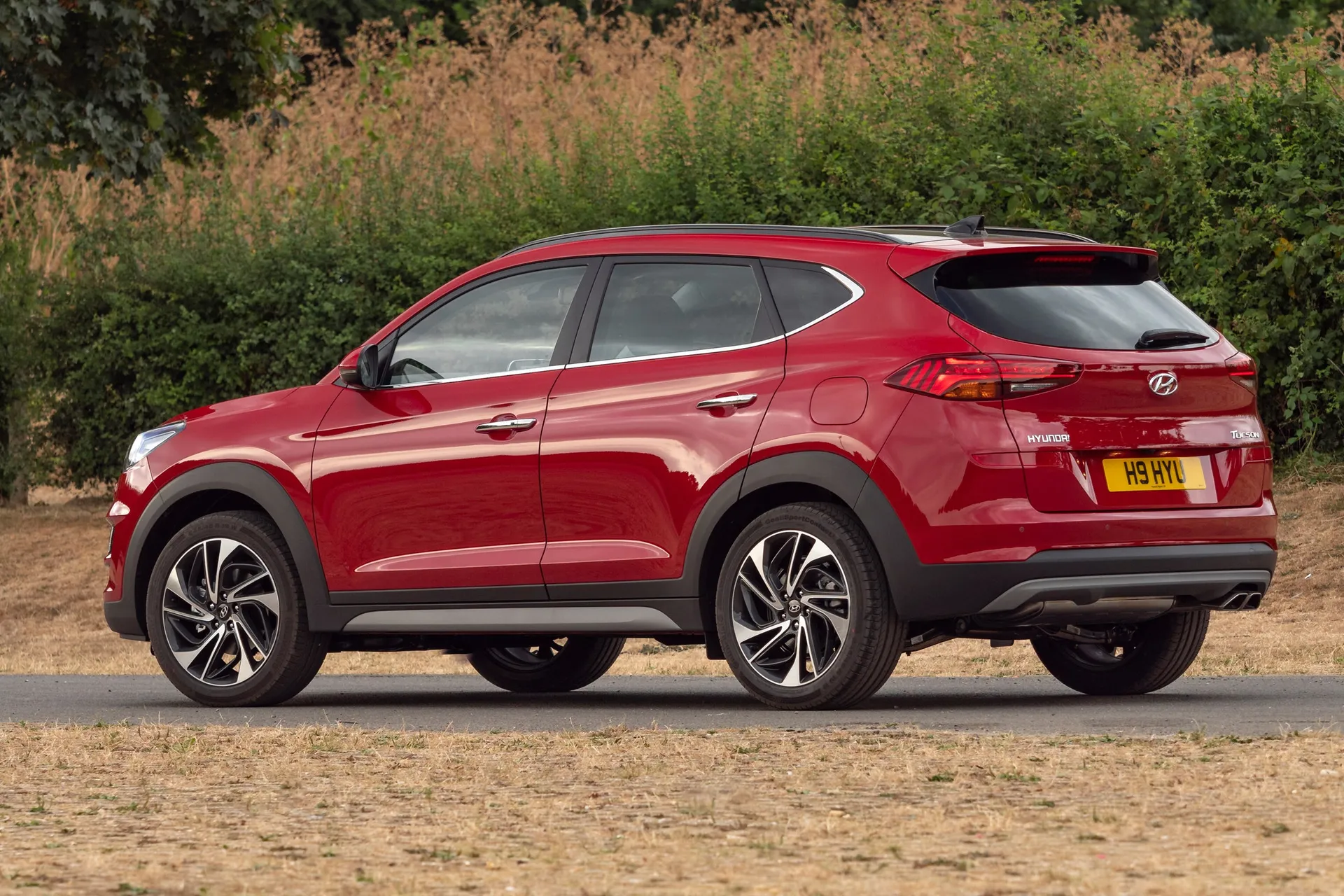
The four-wheel drive 2.0-litre unit is (predictably) thirster, claiming low forties economy, but our owners are seeing a worryingly low 29mpg average, so expect it to realistically fall somewhere in between the two.
You'll struggle to get more than 30mpg out of the 1.6 T-GDi petrol too, although in front-wheel drive guise it should manage mid thirties economy, giving a real world range of over 450 miles thanks to the 60-litre tank. Still, the less powerful diesels can go over 200 miles further between fill-ups, due to their electric assistance.
Insurance groups and costs
Insuring an SUV can be an expensive undertaking, but the best way to stay on top of your annual premiums is by getting the cheapest 1.6-litre petrol model, which sits in Group 13. That's lower than entry-level versions of the Nissan Qashqai and Peugeot 3008, but not quite as affordable as the Skoda Karoq, down in Group 10.
Diesel buyers will be relieved to hear that they'll pay a very similar price for the 1.6-litre with 115PS, since its also Group 13, although going for the beefier 136PS model increases that rating by two bands, to Group 15.
The fully-loaded 2.0-litre diesel with four-wheel drive will be costlier than you might expect, since it's right up in Group 25, four bands higher than a similarly powerful Volkswagen Tiguan. Best avoided if you have a few claims.
VED car tax: What is the annual road tax on a Hyundai Tucson?
Older Tucsons fall under the previous road tax rules, so will pay a variable rate of tax based on their CO2. A two-wheel drive diesel might cost you just £30 every year, whereas the dirtiest versions will be around £240.
Newer models registered after the rule changes came into force in April 2017 will all pay the same £150. This flat-rate applies to all petrol and diesel cars. It includes the mild-hybrids, as they can't move on just electricity.
No Tucson costs more than £40,000 so it avoids the higher 'premium' rate of tax incurred by many premium family SUVs, including posh four-wheel drive versions of the Range Rover Evoque and Audi Q3 for example.
How much should you be paying for a used Hyundai Tucson?
"As a brand Hyundais tend not to hold onto their value quite as well as other marques, and that means there are some really good deals to be had on the used market. Prices for early versions of the Tucson start from under £10,000 for a 1.7-litre diesel, with average mileage for the year, in the desirable SE Nav specification."
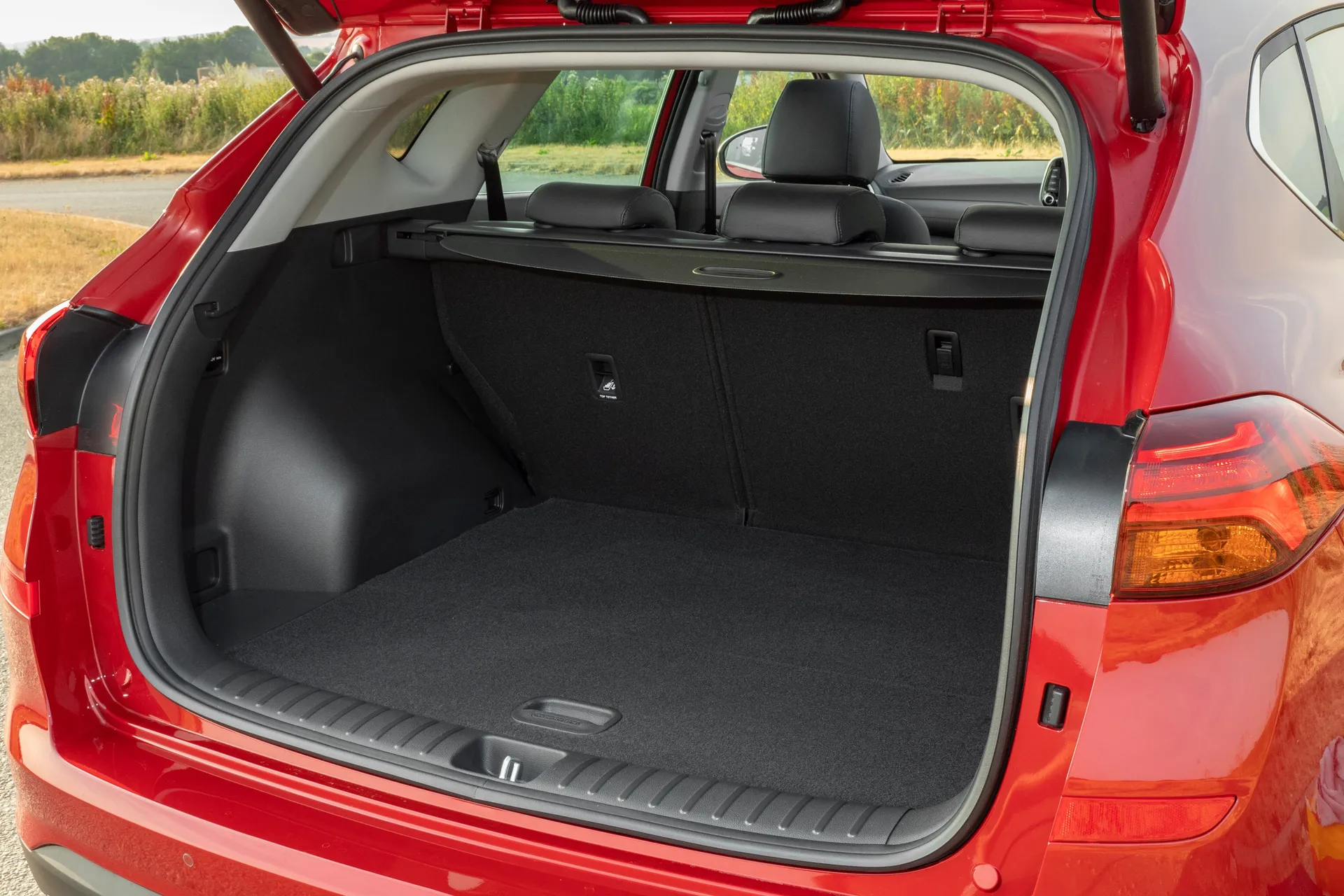
It's not a huge stretch if you need a brawnier 2.0-litre engine and four-wheel drive, as around £12,000 should get you behind the wheel of a car with less than 50,000 miles. We'd be tempted to pay a little bit extra for an example with a full service history, to ensure proper maintenance has been done on the major mechanicals.
However, the pre-facelift version is not as smart inside as the current car. The older diesel engines are quite crude too, forgoing the clever mild-hybrid system available in later model, so they won't be as efficient either.
You'll need to scrape together around £15,000 for the only petrol we recommend, the 1.6 T-GDi, and quite a few of the cars at that price come with an automatic gearbox, where cheaper cars are restricted to manuals.
Push the boat out a little further, and it's possible to find very low mileage versions of the current shape car for less than £20,000, with your choice of engine and trim, and Premium models at this price are great value. Sporty N Line cars carry a small price premium, but still represent a massive saving compared to list price.
Trim levels and standard equipment
Unlike with other car brands, the only optional extra Hyundai offers is metallic paint, which means it's really important that you choose the right trim level for your needs - as you can't add to the spec sheet later on.
Some buyers will love this straightforward approach, which means you don't need to read through the whole brochure to figure out if you'll get lumbar support and parking sensors on the trim level that you can afford.
You needn't worry though, as almost every Tucson comes with a decent level of standard kit, including a reversing camera to help with parking, USB sockets for charging your mobile, and dual-zone climate control.
Our pick is the SE Nav though, which comes with rear privacy glass, automatic wipers, an upgraded 8.0-inch touchscreen and as the name suggests, a built-in navigation system, if you're prefer not to use your phone.
This car does look quite sensible on the outside though. For those who want to jazz up the looks, you might prefer the sporty N line specification. This benefits from heated from seats, a mixture of suede and leather upholstery, all round parking sensors, keyless entry and start and (with some engines) stiffer suspension.
Stepping up to the Premium models and things start to get quite luxurious. You'll get a punchy sound system, electrically-adjustable leather seats, front and rear bum-warmers, and helpful driving aids to boost safety. However the best gadgets are still reserved for the most expensive Premium SE trim, including brighter LED headlights, adaptive cruise control that will brake and steer for you in traffic, and a panoramic glass sunroof.
Ask the heycar experts: common questions
Which is bigger, the Tucson or the Santa Fe?
Is the Hyundai Tucson a good car?
Is the Hyundai Tucson a four-wheel drive car?
Does the Tucson have an automatic gearbox?
Get our latest advice, news and offers
Keep me updated by email with the latest advice, news and offers from heycar.
By submitting you agree to our privacy policy
